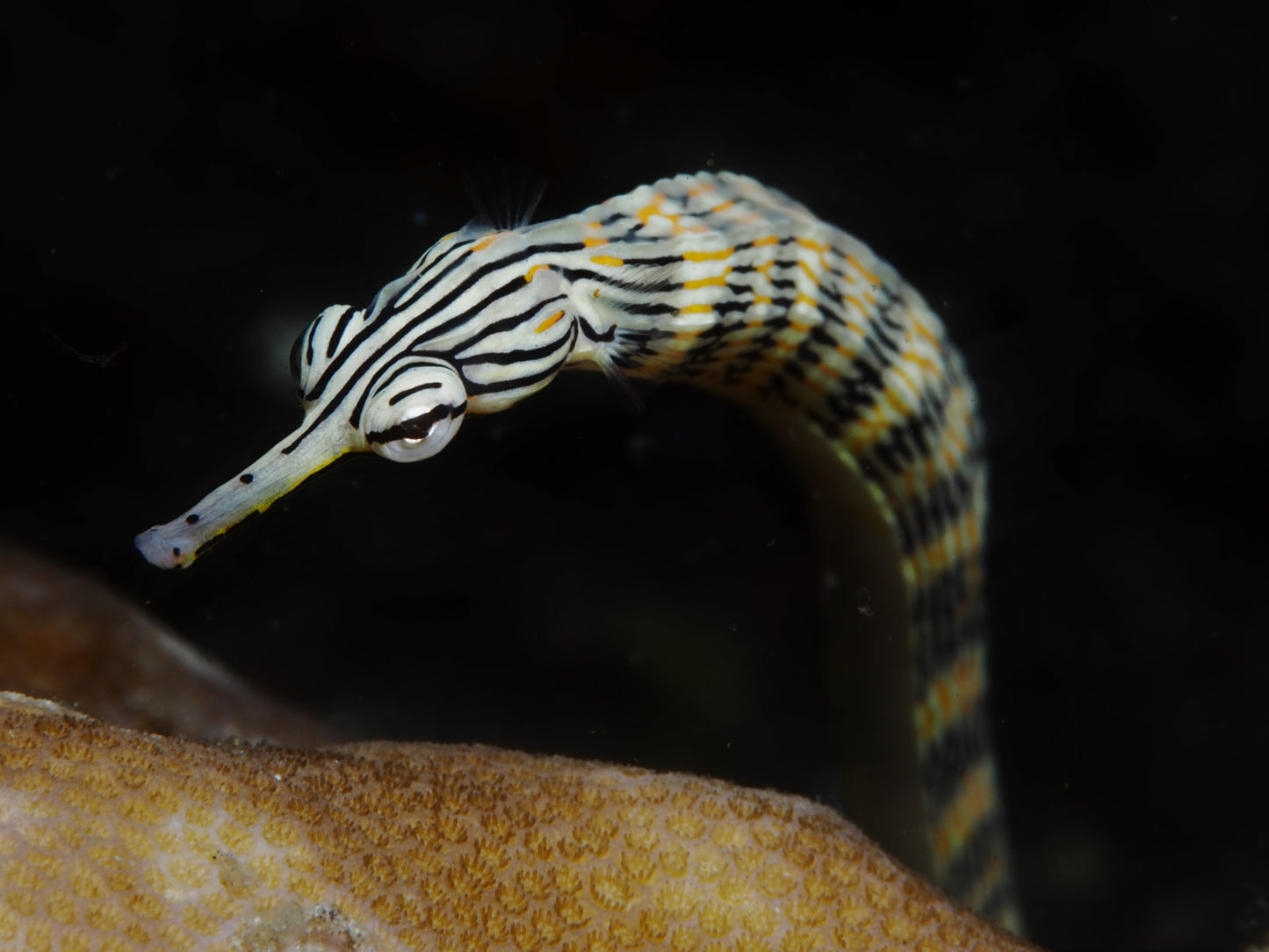Coral Farm Kuwait
Dragonface pipefish - Corythoichthys haematopterus
Dragonface pipefish - Corythoichthys haematopterus
Couldn't load pickup availability
سمكة الأنابيب ذات وجه التنين (Dragonface Pipefish)
تُعرف سمكة الأنابيب ذات وجه التنين أيضاً بأسماء أخرى مثل: سمكة الأنابيب قمة الشعاب (Reeftop Pipefish)، سمكة الأنابيب الزميلة (Messmate Pipefish)، سمكة الأنابيب الشبكية (Network Pipefish)، وسمكة الأنابيب ذات الوجه المخطط (Banded Messmate Pipefish). لهذه السمكة جسم طويل ونحيل مع فم أنبوبي صغير وذيل وردي صغير. لون الجسم كريمي مع علامات سوداء ووردية وصفراء متغيرة للغاية. لكل فرد نمط فريد، وبعضها قد يكون مذهلاً وملوناً بشكل لافت. تم التعرف علمياً على سمكة الأنابيب ذات وجه التنين في جنوب المحيط الهادئ أو تونغا باسم Corythoichthys haematopterus، وفي غرب المحيط الهادئ أو إندونيسيا باسم Corythoichthys intestinalis. وعلى الرغم من وجود اختلافات طفيفة في العلامات، فإن هذه الأسماك تبدو متشابهة جداً وغالباً ما يصعب التمييز بينها. ولزيادة التعقيد، يقترح بعض علماء الأسماك وجود أكثر من 12 نوعاً فرعياً بسبب الاختلافات الإقليمية بين هذه الأسماك.
سمكة الأنابيب ذات وجه التنين سبّاحة ضعيفة وتفضّل التنقل عن طريق انزلاق جسمها فوق الركيزة والصخور الحية بطريقة تشبه حركة الثعبان. كما يمكنها استخدام ذيلها لتثبيت نفسها بشكل فضفاض على الشعاب أو الصخور.
تُعد سمكة الأنابيب ذات وجه التنين من أكثر أنواع أسماك الأنابيب صلابة، لكننا ما زلنا ننصح بأن يقتنيها الخبراء فقط بسبب متطلباتها الغذائية غير المعتادة. فهي عادةً تفضّل تناول الكوببودات الحية فقط في حوض شعاب ناضج يحتوي على الكثير من الصخور الحية أو الطحالب الكبيرة. النظام الغذائي المثالي لبدء هذه السمكة هو Nutramar Tigrio من الكوببودات الحية المعبأة، وروبيان ملحي حديث الفقس مُدعّم بالفيتامينات. ومع ذلك، لا ينبغي أن يشكل الروبيان الملحي الحي معظم غذائها. مع مرور الوقت، قد تعتاد سمكة الأنابيب ذات وجه التنين على تناول السيكلوبس المجمد، الميسيس الصغيرة، وNutramar Ova.
هل تبحث عن أفضل طعام لإطعام سمكة الأنابيب لديك؟ نوصي باستخدام AlgaGen Tisbe biminiensis.
بعد رقصة مغازلة معقدة، تقوم الأنثى بلصق بيضها اللاصق على المنطقة الملساء في الجزء السفلي من جذع الذكر. يمكن لزوج من هذه الأسماك أن يتزاوج بانتظام في الحوض إذا تم تغذيتهما جيداً. يمتلك الذكور البالغون رقعة حضانة ملساء ومسطحة على الجانب السفلي مع طيات جلدية صغيرة على الجانبين.
هذا النوع الاجتماعي يُفضل الاحتفاظ به في أزواج متزاوجة أو مجموعات من نفس النوع في حوض لا يقل عن 50 جالوناً. يمكن الاحتفاظ به مع الأسماك الصغيرة والخجولة مثل القوبيات الصغيرة، فرس البحر، التنينيات، وسمكة النار (Firefish). الأسماك العدوانية أو الإقليمية أو السريعة لا تُعد رفقاء جيدين. سمكة الأنابيب ذات وجه التنين أكثر تحملاً قليلاً للشعاب والأسماك الكبيرة، لكنها قد تتضرر من شقائق النعمان والمرجان ذي اللوامس اللاسعة القوية أو المرجان الكبير بما يكفي لابتلاعها مثل المرجان الدماغي. يمكن أيضاً أن تتضرر من اللافقاريات مثل السرطانات والروبيان الكبير والمحار الكبير، لكنها لا تضر الروبيان الزخرفي أو اللافقاريات الأخرى.
لقد وُجد أن هذا النوع من أسماك الأنابيب يستهلك البراغيث الدقيقة الحمراء (Red Bugs) التي أصبحت شائعة الآن في أحواض الشعاب التي تحتوي على مرجان الأكروبورا. لقد ثبت أن تفشي البراغيث الحمراء على مرجان الأكروبورا يثبط امتداد الزوائد النسيجية ونموها، بينما يسبب تغيرات أو فقدان في اللون. بعد أن تعتاد سمكة الأنابيب على البيئة وزملاء الحوض في حوض الشعاب، ستسعى بسرعة إلى هذه البراغيث الحمراء كمصدر للغذاء.
The Dragonface Pipefish is a poor swimmer and prefers to travel by sliding its body over substrate and live rock similar to the way a snake moves. The Dragonface Pipefish can also use its tail to loosely anchor itself to corals or rocks.
The Dragonface Pipefish is among the hardiest pipefish, but we still suggest expert only aquarist due to its unusual feeding requirements. It normally prefers to eat only live copepods in a mature reef aquarium with plenty of live rock or macroalgae. An ideal diet to start this fish on is Nutramar Tigrio Bottled Live Copepods, and vitamin-enriched live baby brine shrimp. However, live baby brine should not make up the majority of its diet. Over time, the Dragonface Pipefish may become accustomed to eating frozen Cyclops, small Mysis, and Nutramar Ova.
Looking for the best food to feed your Pipefish? We recommend AlgaGen Tisbe biminiensis.
After an elaborate courtship dance, the female will attach her adhesive eggs to the smooth area on the underside of the male's trunk. A pair will regularly mate in an aquarium if well-fed. Mature males have a smooth, flat brood patch on their underside with small skin flaps on both sides.
This social species is best kept in mated pairs or groups of its own kind in an aquarium that is 50 gallons or larger. It may be kept with small, shy fish such as small gobies, seahorses, dragonets, and firefish. Aggressive, territorial, or fast-moving fish do not make good companions. The Dragonface Pipefish is slightly more tolerant of corals and larger fish, but can be harmed by anemones and corals with strong stinging tentacles or corals that are large enough to consume it, such as brain corals. The Dragonface Pipefish can also be harmed by invertebrates such as crabs, large shrimp, and large clams, but will not harm ornamental shrimp or invertebrates.
This species of pipefish has been found to consume the dreaded micro-amphipod commonly referred to as "Red Bugs" that have now become prevalent in reef aquariums that contain Acropora coral. Red Bug infestations on Acropora corals have been shown to inhibit polyp extension and growth, while causing shifts or loss in coloration. After the pipefish is accustomed to the surroundings and tankmates in the reef aquarium, it will quickly seek out these red bugs as a food source.
Share


